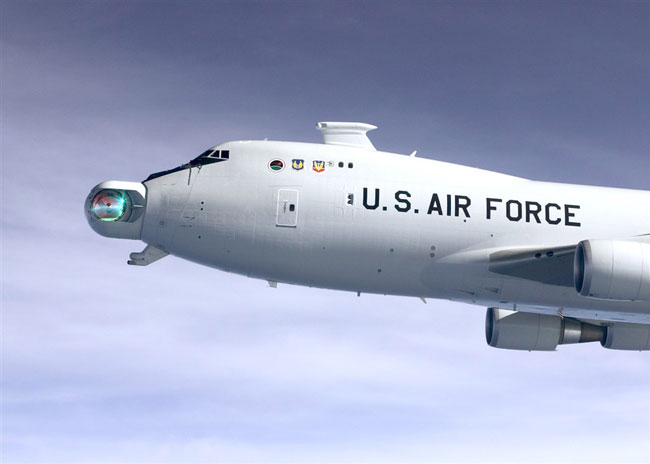Officials Map Out Test Milestones for Airborne Laser

The threat of cancellation no longer looms over the Pentagon's Airborne Laser (ABL) effort, but senior program officials say they are taking nothing for granted as they prepare for a missile-intercept demonstration in 2008.
Several clear test milestones have been laid out for the ABL in 2006 so that senior Missile Defense Agency (MDA) officials will be able to measure its progress, according to Air Force Col. John Daniels, the ABL's program director.
The ABL is a Boeing 747 aircraft being equipped with a high-powered chemical laser to destroy ballistic missiles in their boost phase. Boeing Co. of Chicago is the prime contactor on the effort.
As envisioned, the aircraft would fly in a figure-eight pattern over an area deemed a likely site of a missile launch. Onboard infrared sensors would detect the launch and feed that information into a computer that would direct the laser turret to point at the ascending missile. The turret would then fire two lower-powered solid-state lasers--one to track the missile and one to measure atmospheric distortion--before shooting the high-powered chemical laser at the target.
The ABL program's inability to meet cost and schedule targets in past years once made it a candidate for termination. Just prior to his 2004 retirement, U.S. Air Force Lt. Gen. Ronald Kadish, who was then serving as MDA director, said the program could be canceled if it did not perform well in initial flight and ground tests that were scheduled for late in the year.
Those tests were a flight of the aircraft outfitted with the battle-management and fire-control systems, and a brief firing of the chemical laser on the ground. Both went smoothly, and the senior MDA officials have not invoked similar termination threats in relation to any upcoming ABL test, Daniels said in a telephone interview.
As the 2004 demonstrations approached, markers, called "knowledge points," were laid out to ensure that progress on the program--or lack thereof--would be easy for senior MDA officials and their congressional overseers to gauge, said Daniels, who took over the program in April 2005. He replaced Brig. Gen. Ellen Pawlikowski, who now serves as the director of the Air Force's military satellite communications joint program office.
Breaking space news, the latest updates on rocket launches, skywatching events and more!
The ABL program has a budget of $471.6 million in 2006. Knowledge points laid out for this year include testing of the solid-state lasers for missile tracking and atmospheric-distortion correction. Ground-based tests of those lasers are slated to wrap up in August, with flight-testing to take place by the end of the year, Daniels said.
During the flight test, the lasers will be fired at a military NKC-135 aircraft with a picture of a ballistic missile painted on its fuselage, according to Greg Hyslop, Boeing vice president and ABL program director. While these lasers are relatively low powered, the aircraft will be shielded and the pilots will wear protective goggles, he said.
Also planned for 2006 is the refurbishment of the optical hardware on the high-power chemical laser for a new round of ground testing in 2007, Daniels said.
That hardware has been used extensively over the past 18 months and the military plans to thoroughly clean and inspect it to ensure it is ready for the next series of tests and then 2008 intercept, Daniels said.
MDA has requested $631 million for the ABL effort in 2007. During that year the MDA plans to install the refurbished chemical laser hardware on the 747 aircraft, and run ground tests to prepare for the 2008 intercept demonstration, Daniels said.
Air Force Lt. Gen. Henry "Trey" Obering, the MDA's current director, has indicated that the 2008 demonstration likely will factor heavily into a decision on whether to continue with the ABL program beyond then. The ABL has been positioned as a competitor to the Kinetic Energy Interceptor, a boost-phase missile defense system slated for a flight test in 2008, and MDA officials have indicated that only one of the programs may be funded over the long term.
Daniels said an operational ABL fleet ultimately could consist of seven aircraft.
When it submitted its 2006 funding request to Congress last year, the MDA said it was planning to begin design work on a second ABL aircraft in 2007. The plan accompanying the budget submission for 2007 delays that work to 2009 to take advantage of the lessons learned from the intercept demonstration, Daniels said.
If the 2008 demonstration is successful, it likely would be followed by attempts to shoot down longer-range missiles, Daniels said.
Other work that could follow a successful 2008 intercept demonstration could include testing the ABL against other airborne targets, and possibly using the system to track space debris, Hyslop said during a March 10 briefing for reporters.
- The Power of Light: An Airborne Laser for Missile Defense
- U.S. Air Force Plans for Future War in Space
- Air Force to Focus on Quick Reaction Spacelift Vehicles
Jeremy Singer is a former journalist who specialized in stories about technology, including cybersecurity, medical devices, big data, drones, aerospace and defense. He now works as head of communications at Morse Corp, a company that creates algorithm development, software development and system integration services to solve issues in the aerospace industry.
